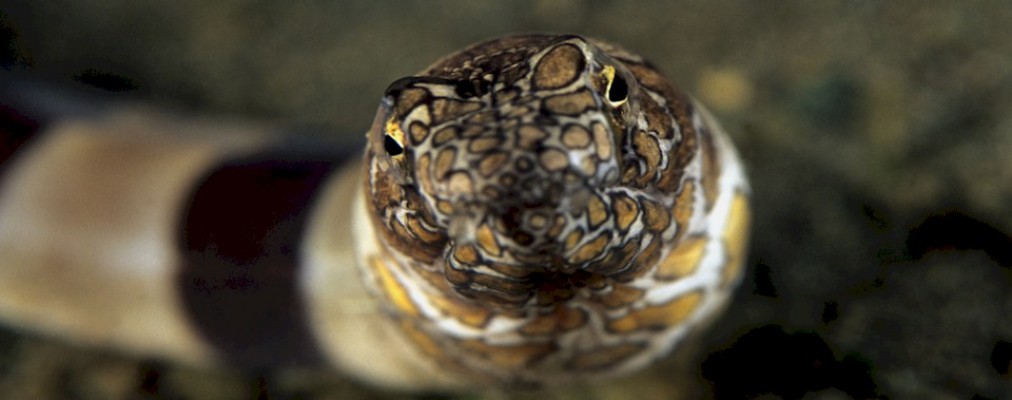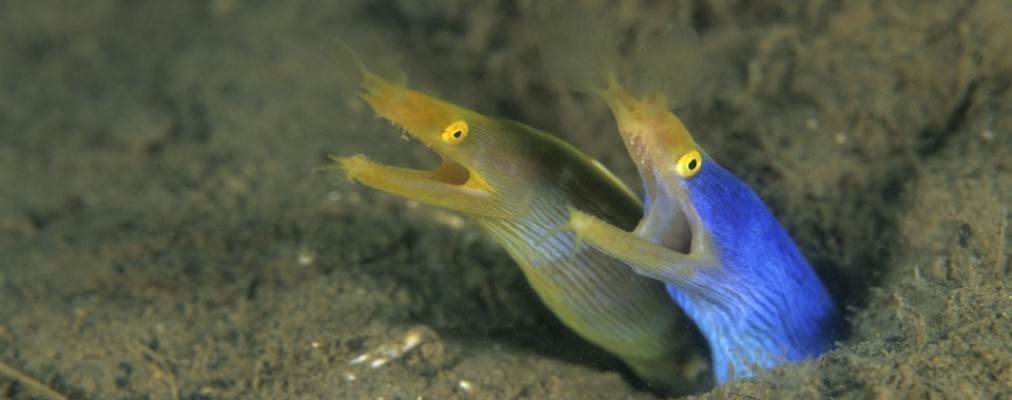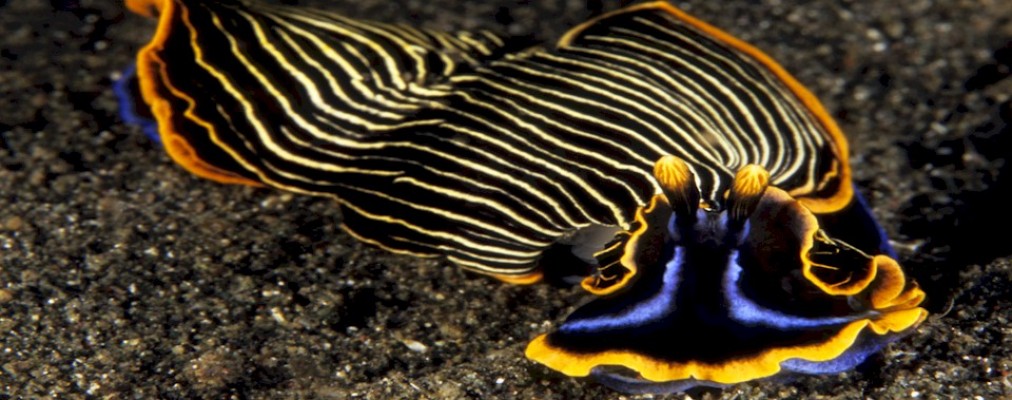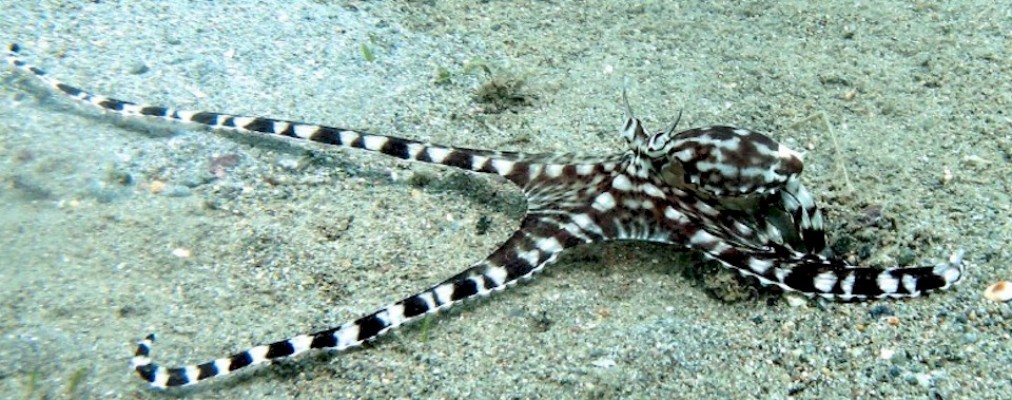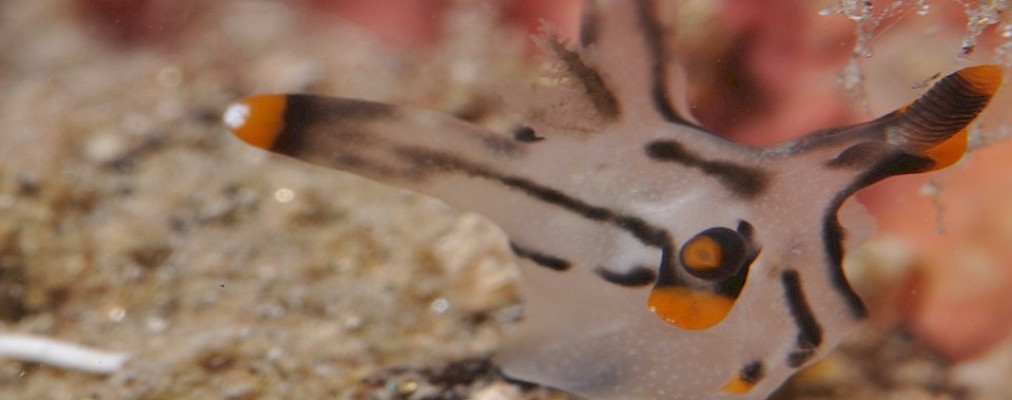Loading content - please wait...
Muck Diving in Gorontalo
Indonesia is famous for muck diving locations. This type of diving originated in Lembeh Strait, not far from Gorontalo. Diving is done over areas of sand, rubble and silt. Hard corals found on reefs are rarely present at muck diving sites. However, the marine life found in muck is unique and spectacular. Miguel’s Diving offers several muck diving sites in Gorontalo.
Mystic Point Dive Site
A tall limestone cliff protects this bay from heavy waves. Generations of fishermen have used this site to anchor their boats. Hence the shallow coral here is not in great shape.
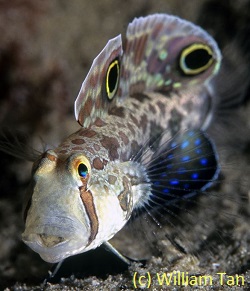
But the white sand slope that descends from the upper coral bank is dotted with fascinating coral bommies. Many species of marine life gather there. Pairs of Crab-eye gobies (Signigobius biocellatus) love this site as well as numerous shrimp species and crabs. What Miguel’s Diving staff call Sea dandelions can be found near patches of coral rubble. Their color is a brilliant maroon. Nudibranchs also favor this site, maybe because there is not so much coral in which to hide!
This site is about 250 meters long.
Depth: 2 – 25 meters
Muck Diving Highlights: cardinalfish, sand anemones, shrimps, crabs and nudibranchs
Conditions: Typical visibility runs 10 meters, but it can reach 18 meters given the right conditions. Any wave action will stir up the sand, as will cold up-wellings and careless fin kicks.
Special Note: Ask Miguel’s Diving staff to find one of the new species available in Gorontalo, the Emperor Akihito fantail goby (Exyrias akihito, 2005). Usually, it lives below 60 meters. Because Gorontalo dive sites directly face the deep ocean, this large and beautiful goby can be seen and photographed at diveable depths. This goby has a spectacular “Mohawk” dorsal fin.
Virtual Muck Diving at Mystic Point
Descend one of the buoy lines used by fishermen to tie their boats. Weedy blennies play hide and seek on these ropes amid tuffs of algae. A large coral bommie comes into view. Schools of cardinalfishes hover around it and mid-size groupers dart in and out. A Tasseled scorpionfish lays camouflaged nearby. The holes and crevasses near the bommie’s base swarm with various shrimps. This includes the red and white spotted Anton Bruuni shrimp. Watch out for the patch of Goniopora coral that looks like a field of flowers. Its polyps give a nasty sting if touched.
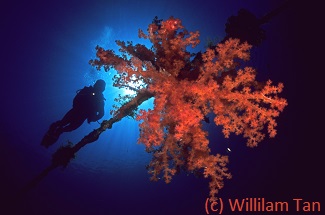
Swimming along the white sand slope, divers spot a large hermit crab and several Blue-lined headshield slugs. At a patch of coral rubble, the dive guide finds another nudibranch. Lionfish guard another large coral bommie. Divers startle a Giant moray eel curled up inside. This one dines on fish parts tossed overboard by village fishermen.
Turning back at a field of colorful daisy coral, search the sand slope at a shallow depth. During the safety stop, the dive guide points out the first of many shy pipefish. Sand anemones of various colors dot the sand-scape. Now that it is time to return to the boat, swim around mooring ropes decorated with soft corals and ascend above the first coral bommie to the waiting dive boat.
Old Port Dive Site
No doubt this is the messiest dive site in Gorontalo! This location served as a port in the days before Indonesian independence. The steep sand and muck slope is strewn with trash from the village above. That creates many places for marine life to hide. A steep sand dune rises above the valley of trash. It seems void of any life unless divers are accompanied by one of Miguel’s Diving’s skilled dive guides. Columns of rock rise from the sand, attracting colorful marine life.
- The site is about 250 meters long.
- Depth: 2 – 25 meters
- Muck Diving Highlights: Harlequin ghost pipefish, ribbon eels, shrimps, crabs and lionfish
Conditions: Typical visibility runs 10 meters. The incoming tide, cold up-wellings and careless fin kicks can reduce visibility during muck diving.
Special Note: The sand slope here is quite steep. Divers unfamiliar with muck diving dive this site with feet towards the slope and head facing below. They stir up lots of sand. Try to keep your fins pointed away from the slope and towards deep water.
Virtual Muck Diving at Old Port
You are told to descend in water so murky that you cannot see your own feet. But below two meters, cooler and clear waters show the tangles of ropes from surface mooring buoys. Picking carefully among the litter, your dive guide points out a colorful wrasse with dense scrawling and a spectacular angular tail. Don’t expect to find Cheilinus bimaculata in your fish book. It is rarely seen in other locations. A pair of Harlequin ghost pipefish try to hover unnoticed nearby. Resting on a banana peel is a rare yellow-colored Dwarf lionfish.
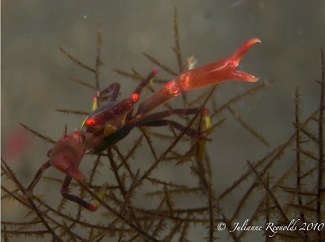
Crossing over the great sand bank, your dive guide beckons to a solitary whip coral where two shrimps cling. Near a rocky pinnacle large lionfish rest in the sand. Clouds of Pink anthias swim near its top. A Banded pipefish stays near its protective crevasse. Your dive guide signals. he has found a juvenile Ribbon eel. It is lender and black with a thin yellow dorsal fin. On the return trip to the trash pit, a dainty baby lionfish waves its translucent fins dotted with pink spots. At the rest stop, a pair of Robust ghost pipefish float like dead leaves as does a large Seahorse.
As you ascend to the surface, you are surrounded by village children clinging to floats. They have been watching you from above.
Sand Castle Dive Site
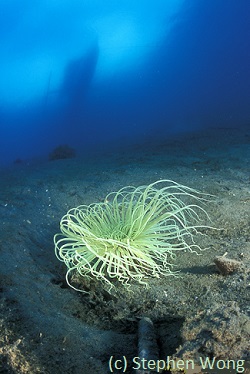
This location is Gorontalo’s first official muck diving site. A shallow shelf at about two meters in depth gives way to a moderate slope that ends in a silt basin at about 20 meters. The sand here is mostly brown in color. Trash is minimal. There are no landscape features.
This site is about 400 meters long.
Depth: 2 – 20 meters
Muck Diving Highlights: Anemonefish eggs, Porcelain crabs, Banded shrimps and unexpected finds
Conditions: Typical visibility runs three to 12 meters. Wave action and careless fin kicks can reduce visibility during the course of a dive.
Special Note: This site contains Gorontalo’s most aggressive fish: the Saddleback anemonefish (Amphiprion polymnus). These fish typically charge divers who pass or approach, chomping their jaws audibly. Usually, they are protecting a patch of eggs located next to their anemone. The eggs will be on a rock or hard surface. New eggs are pinkish and darker eggs are ready to hatch. In fact, the eyes of baby Nemos are visible peering out of the eggs.
Virtual Muck Diving at Sand Castle
Descend onto a level bed of sand rippled by last night’s tide. In front of the boat’s anchor, a colony of White patch garden eels (Heteroconger perissodon) retreat into the sand. These eels are found only in Indonesia and the neighboring Philippines. On the slope below a lone rock, sprouting hydroids and a single whip coral shelters shrimps and a baby lionfish. A single Harlequin ghost pipefish waits for a mate.
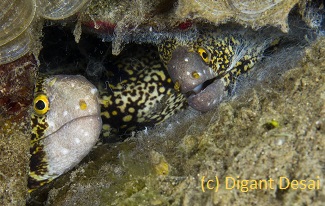
At the level bottom, large shrimpgobies stand guard while their companion shrimps shovel out silt that inevitably spills back into their hole. Anemonefish from a neighboring anemone charge as you pass. They are protecting the eggs developing on a discarded tin can. Your dive guide signals. He has found a Bonaparte eel sticking its freckled nose out of the sand. Ahead a pair of Cockatoo waspfish rock like dead leaves. What looks like tuffs of green algae is really an Ambonian scorpionfish.
On the trip back to the boat, notice the many pink sea pens protruding from the sand. Among the shallow rocks your dive guide has located a tiny Flabellina nudibranch. As you approach the ladder, those garden eel rise to bob and weave in the slight current.
Tambo’o Fish House Dive Site
Gorontalo’s most popular muck site is located just outside the mouth of Bone River where Miguel’s Diving has its dock. Visibility is affected by river water pulled or pushed by long shore currents. Sand here is mostly brown. A shallow sand flat starts at about three meters before a slope of sand begins. Miguel’s Diving typically dives above 18 meters at this site. There is one big coral rock at a relatively shallow depth.
The site is about 200 meters long
Depth: 3 – 18 meters
Muck Diving Highlights: Octopi, moray eels, sea biscuits and unexpected finds
Conditions: Typical varies from runs two to ten meters. River water and careless fin kicks can reduce visibility during the course of a dive.
Special Note: The sand slope here is quite steep. Divers unfamiliar with muck diving dive this site with feet towards the slope and head facing below. They stir up lots of sand. Try to keep your fins pointed away from the slope and towards deep water.
Virtual Muck Diving at Tambo’o FIsh House
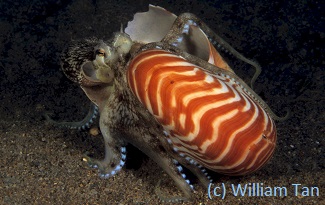
You pass a flounder lying unseen on the sand as you follow the dive guide down the slope. Under an old tire, a pair of White-eyed morays and a Viper-mouth moray jockey for the best view of the visitors who pass. Having no coconuts available, a Coconut shell octopus hauls a beautiful Nautilis shell. Nearby a poorer octopus uses the bottom of a broken bottle as a base for its home. Its sucker hold pieces of glass together to make sides for a home. On a nearby rock your dive guide spots a Tree crab. It is perfectly camouflaged among tufts of algae. Its nose pointed high. Looking like brownish citrus peelings, moon shell eggs lay among the skeletons of Sea biscuits. Usually seen moving about at night, these relatives of sea urchins have a fragile white skeleton. They use hair-like spines to move about the sand.
Dozens of Pink anthias hover about a large coral rock. Many lionfish swim nearby, hoping to swallow an anthias that ventures within reach. Inside the crevasse, a large moray eel is getting its teeth cleaned by a shrimp. Other shrimps hide in small holes in the rock.
On the way back to the boat, your dive guide gives a frantic signal. He has spotted a Mimic octopus. Gathering no too close to its hole, watch as the guide uses his stick to flick up sand. This imitates the actions of some critter burrowing nearby. Its curiosity aroused, the octopus leaves its hole entirely to investigate. When it detects the presence of outsiders, it quickly changes shape to imitate a flounder and glides away.
